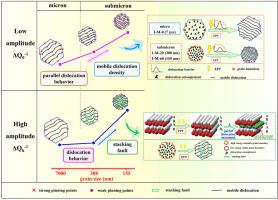Pulse current induced damping enhancement in micron-submicron pure magnesium
IF 13.8
1区 材料科学
Q1 METALLURGY & METALLURGICAL ENGINEERING
引用次数: 0
Abstract
Achieving synergistic enhancement of damping-mechanical performance in pure Mg remains a tough challenge. Electric pulse treatment has proven effective in regulating the microstructure of materials. This work comprehensively investigated the effects of pulse current on the microstructure and damping performance of pure Mg with micron-submicron grains, and revealed the mechanisms of damping enhancement associated with electric pulse treatment. The results suggest that pulse current effectively promotes dislocation disentanglement, thereby increasing the mobile dislocation density. In addition, pulse current facilitates dislocation slip and grain boundary relaxation in submicron samples, accompanied by the generation of high-density stacking faults. The microstructural evolution enhances the damping capacity of pure Mg. After electric pulse treatment, the strain amplitude independent damping (Q0–1) in samples I-Q-0 (7 µm), I-Q-20 (308 nm), and I-Q-60 (155 nm) increased by 17%, 11%, and 14%, while the strain amplitude dependent damping (Qh-1) increased by 5%, 11%, and 54%, respectively. The increment in strain amplitude independent damping capacity ΔQ0–1 is dominated by dislocations. Because pulse current can induce higher mobile dislocation density, contributing to greater energy dissipation and enhanced damping. Besides, the increment in strain amplitude dependent damping capacity ΔQh-1 in micron I-Q-0 (7 µm) sample is also dominated by dislocation behavior. However, in submicron I-Q-20 (308 nm) and I-Q-60 (155 nm) samples, ΔQh-1 is dominated by stacking faults rather than dislocations. Consequently, damping and mechanical properties are synergistically improved in micron–submicron pure Mg by electric pulse treatment.

微米亚微米纯镁中脉冲电流诱导的阻尼增强
在纯Mg中实现阻尼力学性能的协同增强仍然是一个艰巨的挑战。电脉冲处理在调节材料微观组织方面已被证明是有效的。本文全面研究了脉冲电流对微米亚微米晶粒纯Mg的微观结构和阻尼性能的影响,揭示了电脉冲处理增强阻尼的机理。结果表明,脉冲电流能有效促进位错解缠,从而提高可动位错密度。此外,脉冲电流促进了亚微米样品的位错滑移和晶界松弛,并伴随高密度层错的产生。微观组织的演变增强了纯Mg的阻尼能力。电脉冲处理后,I-Q-0(7µm)、I-Q-20 (308 nm)和I-Q-60 (155 nm)样品的应变幅值无关阻尼(Q0-1)分别提高了17%、11%和14%,应变幅值相关阻尼(Qh-1)分别提高了5%、11%和54%。应变振幅无关阻尼能力ΔQ0-1的增加主要由位错控制。因为脉冲电流可以诱导更高的移动位错密度,有助于更大的能量耗散和增强阻尼。此外,在微米I-Q-0(7µm)试样中应变幅值相关阻尼能力ΔQh-1的增加也主要受位错行为的影响。然而,在亚微米I-Q-20 (308 nm)和I-Q-60 (155 nm)样品中,ΔQh-1主要是层错而不是位错。因此,电脉冲处理可以协同改善微米-亚微米纯Mg的阻尼和力学性能。
本文章由计算机程序翻译,如有差异,请以英文原文为准。
求助全文
约1分钟内获得全文
求助全文
来源期刊

Journal of Magnesium and Alloys
Engineering-Mechanics of Materials
CiteScore
20.20
自引率
14.80%
发文量
52
审稿时长
59 days
期刊介绍:
The Journal of Magnesium and Alloys serves as a global platform for both theoretical and experimental studies in magnesium science and engineering. It welcomes submissions investigating various scientific and engineering factors impacting the metallurgy, processing, microstructure, properties, and applications of magnesium and alloys. The journal covers all aspects of magnesium and alloy research, including raw materials, alloy casting, extrusion and deformation, corrosion and surface treatment, joining and machining, simulation and modeling, microstructure evolution and mechanical properties, new alloy development, magnesium-based composites, bio-materials and energy materials, applications, and recycling.
 求助内容:
求助内容: 应助结果提醒方式:
应助结果提醒方式:


